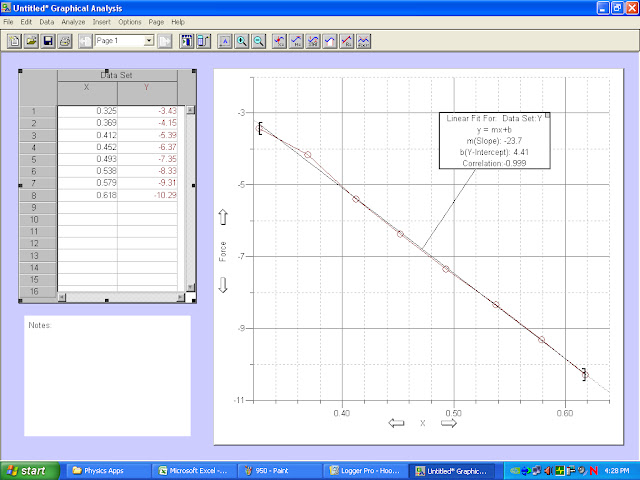In this lab we analyzed the motion of two low friction carts during an inelastic collision and verified that the law of conservation of linear momentum was obeyed. We used the carts and track as shown in the figure. If we regard the system of the two carts as an isolated system, the momentum of this system will be conserved. If the two carts have a perfectly inelastic collision, that is, stick together after the collision, the law of conservation of momentum says that the initial momentum is equal to the final momentum.
Calculations
Pi = Pf
m1v1 + m2v2 = (m1 + m2)V
Pi = m1v1 + m2v2 = (0.5060 * 0.4825) + (0.4995 * 0.4825) = 0.2441 kg * m/s
Pf = ( m1 + m2)V = (0.5060 + 0.4995) * 0.1911 = 0.1922 kg * m/s
v1, v2 = velocities before the collision
V = velocity of the combined mass after the collision.
Data
With the second cart (m2) at rest give the first cart (m1) a moderate push away from the motion
detector and towards m2.
Place an extra 500 g on the second cart and repeat
Remove the 500 g from the second cart and place it on the first cart and repeat
Trial
|
Percent
Difference (%)
|
1
|
21.3
|
2
|
15.61
|
3
|
10.06
|
4
|
3.83
|
5
|
9.31
|
6
|
8.27
|
7
|
3.55
|
8
|
4.12
|
9
|
3.87
|
Average
|
8.88%
|
Theoretical
calculations for ΔK/K in a perfectly inelastic collision of three
situations:
1. a
mass, m, colliding with an identical mass, m, initially at rest.
2. a
mass, 2m, colliding with a mass, m, initially at rest.
3. a
mass, m, colliding with a mass, 2m, initially at rest.
1. (m with v) collides with (m initially at rest).
mvb =
2mva vb = 2va
K =
(1/2)*m*(vb)^2
ΔK =
(1/2)*2m*(va)^2- (1/2)*m*(vb)^2
ΔK/K=
-50%
2. (2m with v) colliding with (m initially at rest).
mvb =
3mva vb = 3va
K = (1/2)*m*(vb)^2
ΔK = (1/2)*3m*(va)^2- (1/2)*m*(vb)^2
ΔK/K= -66.7%
3. (m with v) colliding with (2m initially at rest).
2mvb = 3mva vb = (3/2)va
K = (1/2)*2m*(vb)^2
ΔK = (1/2)*3m*(va)^2- (1/2)*2m*(vb)^2
ΔK/K= -33.3%
Conclusion
From this lab I learned that momentum is conserved. In the inelastic collision the two carts with different masses and velocities impact each other, stick together, then become one mass with one velocity. We did a run where a mass with a velocity impacted a mass that was at rest, a run where a twice the mass with a same velocity crashes into a mass that is at rest, a run where a mass with a velocity crashed into a cart with twice the mass. In every trail momentum was conserved. The law
is somewhat consistent. As we started adding weights to the carts we the
difference became less. The increase of weight had a dampening effect on the
results of this experiment. Our overall average was 8.8% difference, which
shows that momentum is mostly conserved. Something that could have affected it
were air drag, friction, and the table not being perfectly level, the carts also stuck together by velcro patches which couldve contributed to our percent error.











